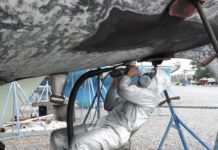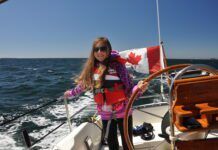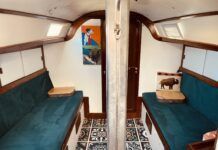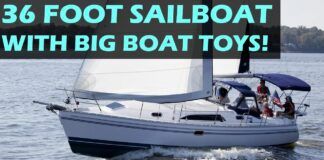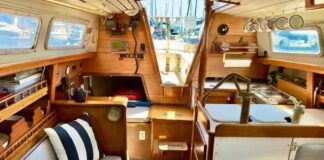To commence its first-ever test of high-gloss topsides paint, Practical Sailor about a year ago applied a colorful “bracelet” on the editor’s work boat—a 13′ Boston Whaler that had seen 35 years of heavy duty. The skiff’s topsides were chalked, faded, gouged and scratched. It was long accustomed to random acts of unkindness; it begged only for a new paint job.
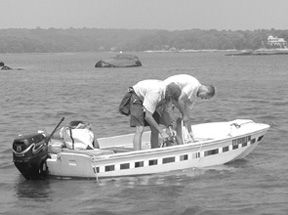
It got the paint job—plus “The Bracelet,” a 3″ strip broken into 39 segments of mostly red, white and blue paint from 10 manufacturers. To even out exposure, the 39 segments were repeated, port and starboard. One set ran from bow to stern, the other from stern to bow.
Essentially, this was intended to be a test of high-quality, one-part marine topside paints. Also included for comparison with the many gloss enamels, however, were a couple of expensive two-part paints, one cheap hardware-store variety, and a top-of-the-line but inexpensive water-based acrylic from a huge paint company.
The objective was to expose the 78 rectangular samples to the elements—take it as it comes—and see, first of all, which lasts the longest, and secondly, if common paints can stand up to their high-bred competitors.
For those interested in the detail, the rationale for the choices and the colors was explained in an initial report published in the February 15, 2002, issue, along with explanations of the prep and application techniques used. (Generally, each manufacturer’s instructions were treated as gospel.) That first report dealt with how the paint handled while being applied, how well one coat covered, and the quality of the gloss. Those three qualities were combined in an overall initial rating. This data is shown on the chart (see PDF at the end of the story) in the column grouping labeled “Ratings at Application.”
At that point they all looked as good in one coat as they ever would. After all, paint almost always looks beautiful when new. More important is what it looks like after a season or more of use by those who do the boat no favors—no wax, no pampering (“There’s work to be done!”), not even an occasional wash to remove sand and salt crystals. Here there can be (and was) some shifting in the ranks when it comes to how they hold up relative to each other.
So this is our end-of-the-first-year report on how the paints dealt with eight months of hard usage in coastal Connecticut salt water, plus four months upside down, uncovered, in the Connecticut winter of ’01-’02 (not a bad winter, as it turned out).
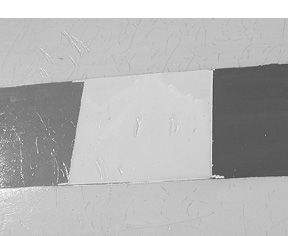
Some winners seem to be emerging, but again, it’s only been a year, with a single coat. Early judgements must be tempered against time. PS found that out with varnishes and teak treatments. A few can be marvelous debutantes, but later, as they age, have trouble filling their dance cards.
As might be expected, three expensive two-part paints (Awlgrip, Interthane Plus, and Epifanes’ Poly-Urethane) are the early leaders.
A few one-part premium yacht enamels are not doing so well.
A couple of those plain old paints from the hardware store are looking better than you might expect. However, one is already an abject failure.
Although it greatly complicated the job (but enhanced the appearance of the boat), PS selected red, white and blue in most of the paints. That was to check the darker colors’ longtime reputation for fading fast.
The data shows this to be true in most cases, especially with the color red—and that’s at least partly why 90% of the paint sold for boats is white. More time probably will accentuate the weakness of the dark colors.
For this report, the bracelet was given a good freshwater wash and wipe, then the gloss of the bracelet segments on both sides of the boat was carefully eyeballed for reflectivity. Gloss was then weighed with other evaluations of the general appearance and state of coverage for each square. (We completely discounted dings, abrasions, and Acts of Editors.)
In a few cases, the matching, opposite-side panels appeared different enough that the port/starboard ratings were not the same, but none was more than one step away on the Excellent-Good-Fair-Poor ladder. Considering the take-it-as-it-comes exposure, this is to be expected.
When a pairing differed, the better of the two ratings was entered in the chart. The differences were too minimal to average out, and will certainly be further minimized as time goes by.
You’ll also notice that in some cases, the one-year ratings are more favorable than the original assessments. Again, remember that these are relative ratings—and what a difference a year can make. A few paints that looked gorgeous at the start didn’t fare so well under the ravages of time, while others that may have appeared a bit plain at the beginning have proved themselves hardy and true. (Have we wrung enough out of this analogy yet?) This applies particularly to some two-part paints, which tend to be thin and don’t show well with one coat. But they last—look at how the Awlgrip fared.
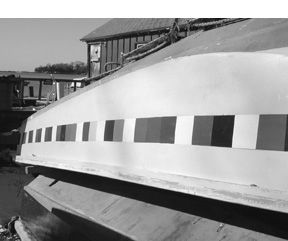
As it now stands, the topsides paints that earned Excellent marks overall are Interlux’s two-part Interthane Plus in red and white; Interlux’s Toplac in white, and Epifanes’ Mono-Urethane in blue (the only color used of this paint). Fourteen of the paints rated Good overall; 19 rated Fair. They are shown on the chart.
There were three Poor ratings for gloss only at the one-year mark, and two overall Poors—one was the single entry from Ace Hardware—the green Royal alkyd (from which nothing much was expected). The other was the Epifanes alkyd Yacht Enamel in red—a bit odd, since its blue and white siblings did quite well.
A mild but pleasant surprise was that a revered old name—Rust-Oleum—is hanging in there with some much more expensive coatings. It may smell like fish, from whose oil it’s made, but this $9-a-quart paint is doing OK—so far. (For best results, you’d have to paint your boat brown.)
The hunt continues here for a paint that’ll tote that barge for a couple of years, which is about all one might expect in a one-coat test. We’ll check in again a year from now.
Also With This Article
Click here to view “Topside Paint Ratings.”
Contacts — Andek Corp. 856/786-6900, www.andek.com. Epifanes North America, 800/269-0961, www.epifanes.com. Interlux, 800/468-7589, www.yachtpaint.com. Pittsburgh Paints, 800/441-9695, www.pittsburghpaints.com. Rust-Oleum, 800/553-8444, www.rustoleum.com. Pettit & Kop-Coat, 800/221-4466, www.kop-coat.com. U.S. Paint, 314/621-0525, www.uspaint.com. West Marine, 800/262-8464, www.westmarine.com.


















